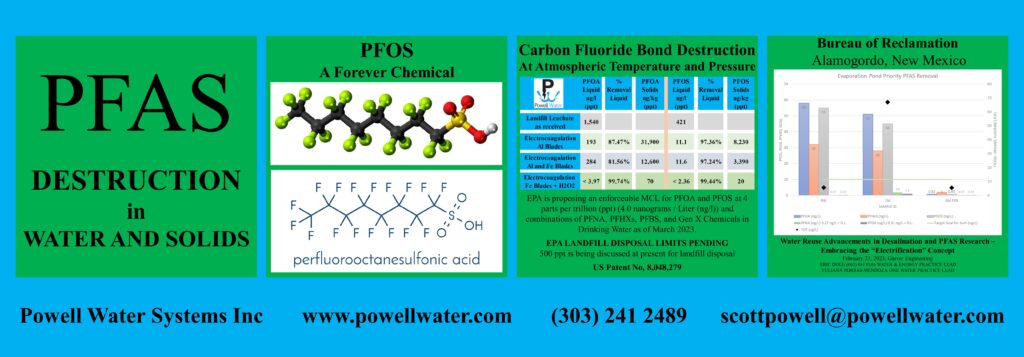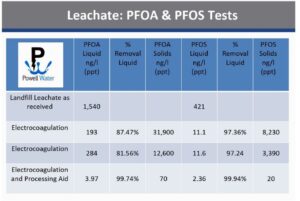Patented Powell Water Electrocoagulation destroys PFAS, creates clean water, and destroys the Fluorine Carbon bonds.
AWWA Water Science (2021) article on Drinking Water PFOA PFOS Destruction with EC AWWA
Presentation of PFAS, PFOA, and PFOS in a Rural Water context crwa conference ec 2023
Presentation on PFOS and PFOA given by the Florida Rural Water Association for the EPA FRWA on PFOS

PFAS NRWA 2023
Abstract
PFAS – PFOA – PFOS, the forever chemicals, are becoming recognized as dangerous to the environment. Treatments like Activated Carbon Filters, Ion Exchange Systems, and Reverse Osmosis Systems concentrates the PFAS into hazardous waste. These expensive treatments do not eliminate the toxic elements without further encapsulation, incineration, or deep well injection. Powell Water’s patented and proven technology, breaks the carbon fluorine bond, creating water for reuse or discharge, and leaves inert safe environmentally friendly solids. This simple, costs effective process is the best way to eliminate PFAS, PFOA, and PFOS.
Historical context of Fluorine Carbon bonds.
PFOA, perfluorooctanoic acid, and PFOS, perfluorooctane sulfonate, commonly described as PFAS, perfluoroalkyl substances was first developed in the 1940s and commercialized in the 1950s into wonderful products like Scotchgard, life-saving firefighting foams, which to this day can only be met with PFAS-based surfactants, given their unique and life-saving properties. (History of PFAS and 3M)
The compounds combine a fluorine and carbon bond (Perfluorooctane | C8F18 – PubChem (nih.gov) and became the building blocks for Teflon nonstick cookware, Teflon plumbing tape, Teflon lubricants, Teflon tubing, Cerave Body Wash With Salicylic Acid, Cerave Hydrocortisone Cream, Aquagear Water Filter Pitcher, Cerave Moisturizing Cream, Refresh Relieva PF Lubricant Eye Drops, Nature’s Life PFO Pure Fish Oil, Approved Science Male Enhancement, Super Poli-Grip Super Poligrip Original, Olay Quench Body Lotion, pesticides, herbicides, firefighting foams, and etcetera.
Environment concerns of Fluorine Carbon bonds.
The United States Environmental Protective Agency has learned that PFAS are widely used, long lasting chemicals, components of which break down very slowly over time. Because of their widespread use and their persistence in the environment, many PFAS are found in the blood of people and animals all over the world and are present at low levels in a variety of food products and in the environment. PFAS are found in water, air, fish, and soil at locations across the nation and the globe. Scientific studies have shown that exposure to some PFAS in the environment may be linked to harmful health effects in humans and animals. (PFAS Explained | US EPA)
Destruction of the Fluorine Carbon bonds.
Traditionally PFAS has been removed from water with Activated Carbon Filters, Ion Exchange Systems, and Reverse Osmosis Systems. They remove the PFAS from the water by concentrating the PFAS in a waste product that became more hazardous than the source of the PFAS originally. The long-term disposal of the concentrated PFAS is a long-term environmental concern.
Princeton University researchers have identified the bacterium, Acidimicrobium bacterium A6, which removed 60% of PFAS — specifically perfluorooctanoic acid (PFOA) and perfluorooctane sulfonate (PFOS) — in lab vials over 100 days. (Microbe chews through PFAS and other tough contaminants (princeton.edu))
Powell Water Systems Inc offers a patented and commercialized electrocoagulation process that not only separates the PFAS from the water, but also destroys the PFAS in the coagulate solids in less than two hours. The Powell electrocoagulation process is effective on drinking water (Alabama Water Utility), clean river water (West Morgan East Lawrence Water and Sewer Authority), Publicly Owned Treatment Works (POTW) sewage discharge water (Widefield Water & Sanitation District), Firefighting wastewater (Buncefield England), and on mixed landfill leachate water (Inkster MI).
Analytical test showing PFOA and PFOS destruction
Landfill leachate water containing oil and grease, heavy metal ions, biochemical oxygen demand, and suspended solids in addition to the PFOS and PFOA was processed through a Powell electrocoagulation chamber operating with a one to three-minute residence time, one minute alternating current, and atmospheric chamber using bipolar blades.
The PFOA and PFOS was measured in the incoming landfill leachate water, in the clear water following Powell electrocoagulation and coagulated solids separation, and the coagulated solids collected on an 11-micron Whatman # 1 filter paper. The results are shown in Table 1.
Table 1. landfill leachate water treated under three conditions with Powell electrocoagulation. Aluminum blades, Aluminum and Iron blades, and Iron blades with hydrogen peroxide.

Capital and Operating Cost
The level of PFOA and PFOS water treatment will be determined by government regulators. The operating cost for simple aluminum blades water treatment is less than $0.01 per gallon. The complete destruction with iron blades and hydrogen peroxide is $0.03 per gallon.
The capital cost is site dependent.
Conclusion
Powell electrocoagulation reduced PFOA and PFOS below proposed discharge limits for water, and coagulated solids with the use of iron blades and hydrogen peroxide are below the suggested limits for liquid discharge. By destroying the fluoride carbon bond, the environment is safe from PFOA and PFOS contamination
